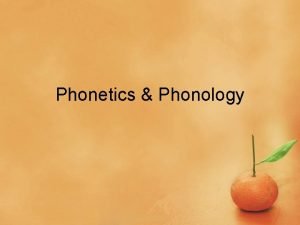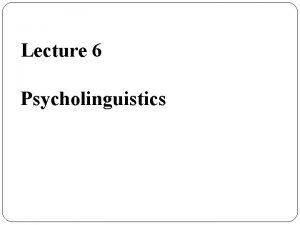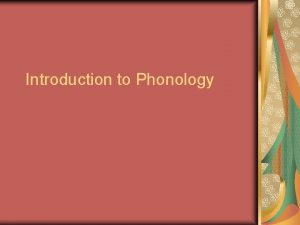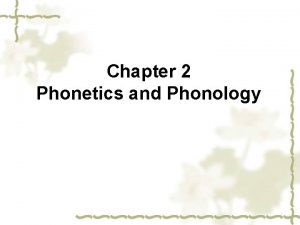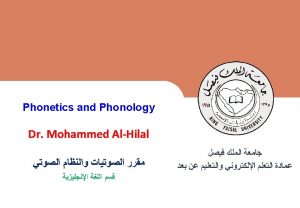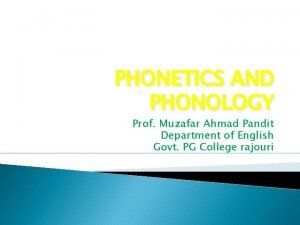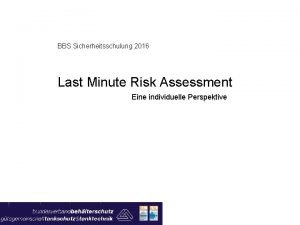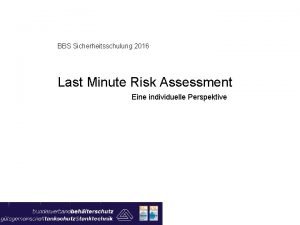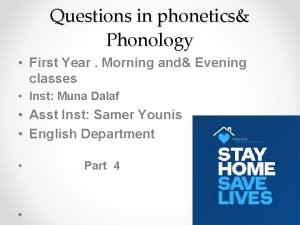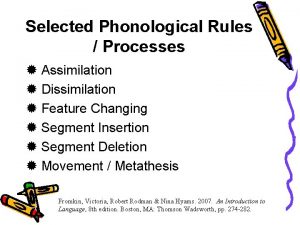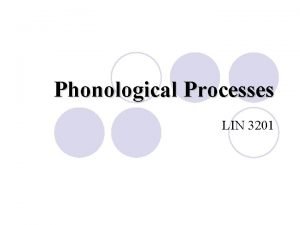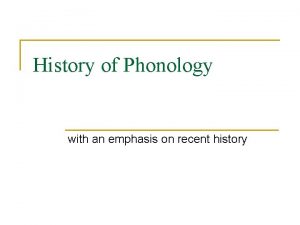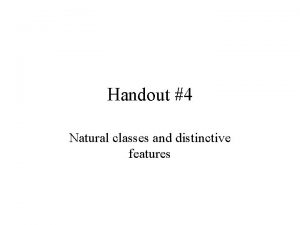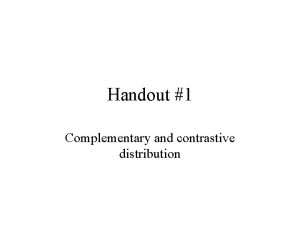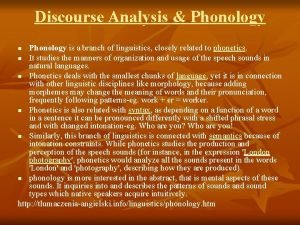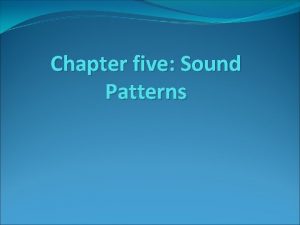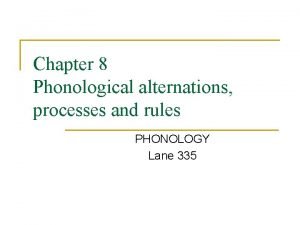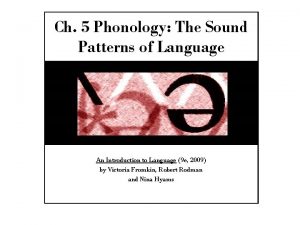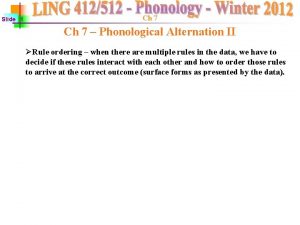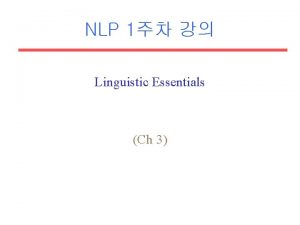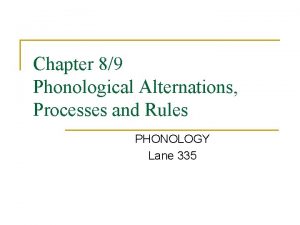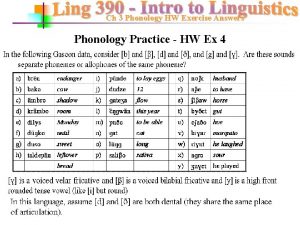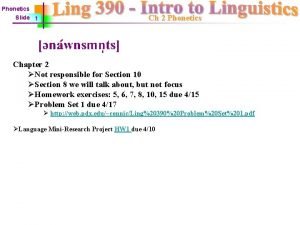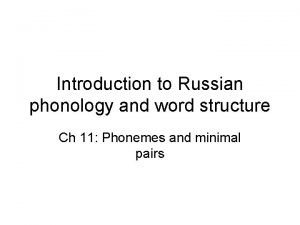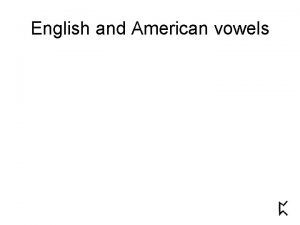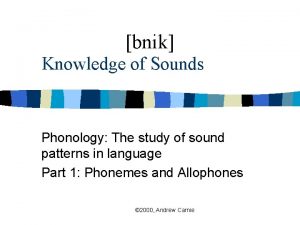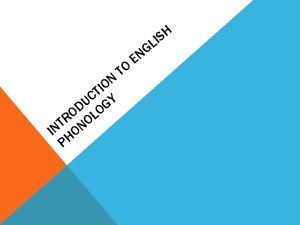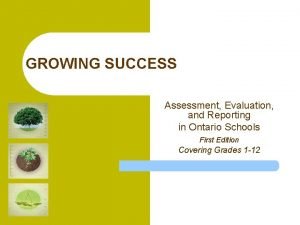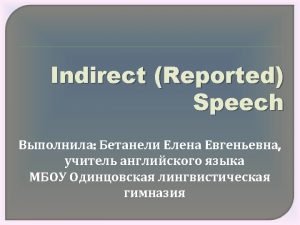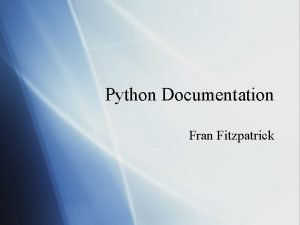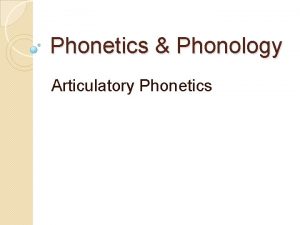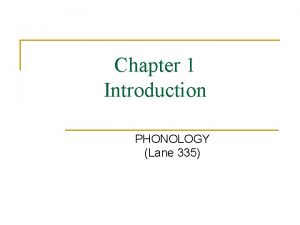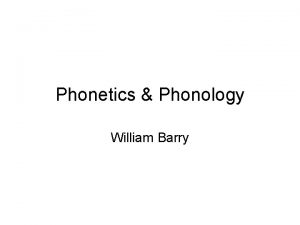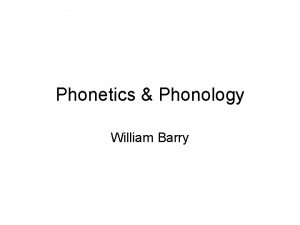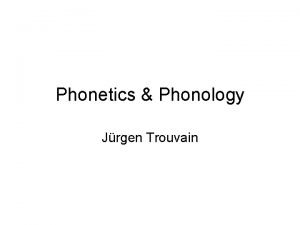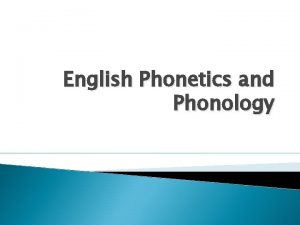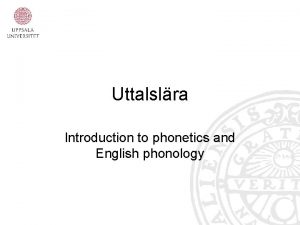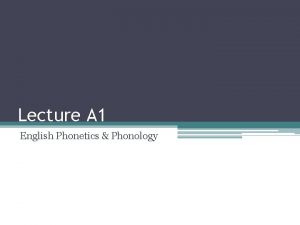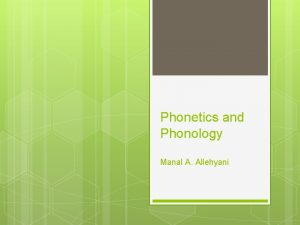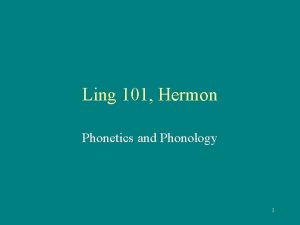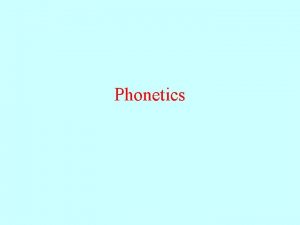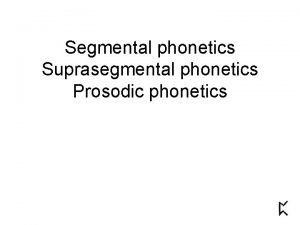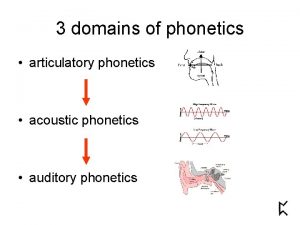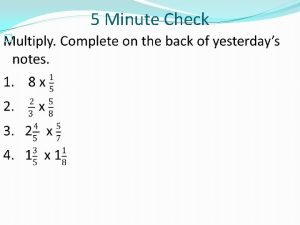Phonology Questions Comments Last minute Phonetics questions Phonetics


















![Phonology 14 Phonology Ø English – one phoneme /p/ and allophones include [p] and Phonology 14 Phonology Ø English – one phoneme /p/ and allophones include [p] and](https://slidetodoc.com/presentation_image_h/1eb39f83c82f676fb938232293a27df1/image-19.jpg)












![Phonology Practice 27 Phonology Practice Data from Zinacantec Tzotzil: Consider [p] and [p´] ; Phonology Practice 27 Phonology Practice Data from Zinacantec Tzotzil: Consider [p] and [p´] ;](https://slidetodoc.com/presentation_image_h/1eb39f83c82f676fb938232293a27df1/image-32.jpg)






![Phonology 34 Phonology Ø Major class features Ø [ consonantal] - major obstruction in Phonology 34 Phonology Ø Major class features Ø [ consonantal] - major obstruction in](https://slidetodoc.com/presentation_image_h/1eb39f83c82f676fb938232293a27df1/image-39.jpg)
![Phonology 35 Phonology Manner features Ø [ continuant] – sounds with free or nearly Phonology 35 Phonology Manner features Ø [ continuant] – sounds with free or nearly](https://slidetodoc.com/presentation_image_h/1eb39f83c82f676fb938232293a27df1/image-40.jpg)
![Phonology 36 Laryngeal features Ø [ voice] – vocal folds vibrating or not Ø Phonology 36 Laryngeal features Ø [ voice] – vocal folds vibrating or not Ø](https://slidetodoc.com/presentation_image_h/1eb39f83c82f676fb938232293a27df1/image-41.jpg)

![Phonology 38 Phonology Place o’ articulation features LABIAL Ø [ round] – sounds produced Phonology 38 Phonology Place o’ articulation features LABIAL Ø [ round] – sounds produced](https://slidetodoc.com/presentation_image_h/1eb39f83c82f676fb938232293a27df1/image-43.jpg)


![Phonology 41 Consonants (C) LABIAL [+ high] CORONAL DORSAL [– strident] [– round] [+ Phonology 41 Consonants (C) LABIAL [+ high] CORONAL DORSAL [– strident] [– round] [+](https://slidetodoc.com/presentation_image_h/1eb39f83c82f676fb938232293a27df1/image-46.jpg)
![Phonology 42 DORSAL Vowels (V) [+ tense] = LABIAL [+ high] [– low] [+ Phonology 42 DORSAL Vowels (V) [+ tense] = LABIAL [+ high] [– low] [+](https://slidetodoc.com/presentation_image_h/1eb39f83c82f676fb938232293a27df1/image-47.jpg)

















- Slides: 64

Phonology Questions? Comments? Last minute Phonetics questions?

Phonetics Slide 13 Phonology PHONETICS - Chapter 2 Consonants: Order of 3 -part descriptive terms: Voicing -- Place o’ Articulation -- Manner o’ Articulation

Phonetics Slide 21 Phonology English Consonants (voiceless sounds on the left)

Phonetics Slide 25 Phonology vowel words

Phonology Chapter 3 – Difficult! ØChapter 3 – Phonology ØChapter 3 Exercises: 4, 5, 7 (Due 4/24) Ø Click here or link below for better directions for Ex 4 and 5 – do not follow the directions in the book or you will be confused! Ø http: //web. pdx. edu/~connjc/Directions%20 for%20 LING%20390%20 Ch%203%20 Exx% 204%20 and%205. pdf ØProblem Set 2 (Due 4/29) – very tricky – look it over to make sure you don’t have any questions!

Phonology 1 Phonology Ø The component of the grammar that determines the selection of speech sounds and that governs both the sound patterns and the systematic phonetic variation found in language. Ø Segments (phones, sounds) - what we learned from phonetics Ø Features - parts of phones Ø Syllables - putting phones together in a larger structure

Phonology 2 Phonology Ø Looking for meaningful contrast between sounds Ø(distinctive sounds, sounds in opposition) Ø Minimal Pairs - 2 forms with distinct meanings that differ by only 1 segment found in the same position in each form (p. 59) Ø Like 2 words that rhyme (minimal pairs test for consonants) Ø sip and zip show a meaningful difference between the segments [s] and [z]

Phonology 3 Phonology Ø Environment - the phonetic context in which a sound occurs Ø Near minimal pairs - like minimal pairs but environments aren’t entirely identical Ø Near minimal pairs used if minimal pairs can’t be found Minimal Pair sip and zip show a meaningful difference between the segments [s] and [z] Near Minimal Pair author and either show a meaningful difference between the segments

Phonology Practice Phonology 4 Phonology Ø Minimal Pairs Practice

Phonology Practice Phonology 5 Phonology Ø For each of the following pairs of English consonant phonemes, find a minimal pair /p/ /b/ /t/ /d/ /k/ /g/ /p/ /f/ /m/ /n/

Phonology 6 Phonology Ø Minimal pairs used to find phonemes Ø Phonemes - segments that contrast with each other in a particular language belong to separate phonemes (p. 60) Ø Can’t always find MP for all phonemes in all environments Ø only occur in certain environments in English

Phonology 7 Phonology Ø English phonemes are shown on pages 60 -61 Ø Note that there is no glottal stop or flap on the consonant chart - why?

Phonology 8 Phonology Ø English phonemes are shown on pages 60 -61 Ø Note that there is no glottal stop or flap on the consonant chart - why? Ø What is considered a phoneme is language specific Ø If we say in English “do Len” we can change length of vowels and consonants and it’s doesn’t change the meanings of the words - Finnish no ØLength in Finnish contrastive for both cons and vowels

Phonology 9 Phonology Ø Systematic variation - predictable changes in segments in certain environments Ø Not all ls are the same - who was surprised? Only voiceless [l] occurs after voiceless stop, so it is predictable. No voiced [l] occurs in this environment.

Phonology 10 Phonology Ø When 2 or more sounds never occur in the same environment then they are in complementary distribution

Phonology 11 Phonology Ø When 2 or more sounds never occur in the same environment then they are in complementary distribution voiceless stop aspirated voiceless stop unreleased voiceless stop

Phonology 12 Phonology Ø Allophones - When two or more segments are phonetically distinct but phonologically the same (predictable variation). at the Daily Planet saving the world at Darcelle’s

Phonology 13 Phonology Ø Phonetic representation - shows allophones and all information about segments that is phonetically produced (manila folders) Ø Phonemic representation - only shows phoneme (green hanging file folder) Phonemic representation Phonetic representation /p/
![Phonology 14 Phonology Ø English one phoneme p and allophones include p and Phonology 14 Phonology Ø English – one phoneme /p/ and allophones include [p] and](https://slidetodoc.com/presentation_image_h/1eb39f83c82f676fb938232293a27df1/image-19.jpg)
Phonology 14 Phonology Ø English – one phoneme /p/ and allophones include [p] and [ph] Phonemic representation Phonetic representation /p/ [p] [ph] Ø Thai – 2 phonemes /p/ and /ph/ Phonemic representation /p/ /ph/ [p] [ph] Phonetic representation

Phonology 15 Phonology Ø Searching for generalizations about systematic variation of sounds In English, liquids and glides have voiceless allophones after voiceless stops, and voiced allophones elsewhere.

Phonology 16 Phonology ØComplementary Distribution - remember that the phoneme /p/ has 3 allophones: Environments Phonetic Environments Examples # ___ word initial ___ # word final s ___ after [s] ___ C before a consonants C ___ V between a consonant and a vowel V ___ V between two vowels V ___ # word-final after a vowel C ___ # word-final after a consonant

Phonology 17 Phonology

Phonology Practice 18 Phonology Practice Yes - minimal pairs 1 -7; 2 -8; 3 -9; 4 -10 so:

Phonology Practice Phonology 19 Phonology Practice Phonetic Environments # ___ word initial ___ # word final s ___ after [s] o ___ e between [o] and [e] Phonetic Environments ___ C before a consonant C ___ V between a consonant and a vowel V ___ V between two vowels V ___ # word-final after a vowel C ___ # word-final after a consonant

Phonology 20 Phonology organize your data

Phonology Practice Phonology 21 Phonology Practice Phonetic Environments # ___ word initial ___ # word final s ___ after [s] o ___ e between [o] and [e]

Phonology Practice Phonology 22 Phonology Practice Organize your data! = Where does each sound occur? List the specific immediately preceding sound and the specific immediately following sound (don’t generalize yet!) before [a], [o], [e], [o: ], word initially, etc elsewhere [t] [t. S] [ts] #_a o_o #_i #_u a_a #_e i_i u_u u_a #_o u_i a_u i_o: o_e all before [i] all before [u]

Phonology 23 Phonology • Underlying representation (UR) - the unpredictable phonological information represented in a phonemic representation (green folders) • Surface representations (PR) - the phonetic representations (manila folders) • We use rules (formalized phonological processes) to derive the PR from the UR

Phonology Practice 24 Phonology Practice

Phonology 25 Phonology Review Ø The component of the grammar that determines the selection of speech sounds and that governs both the sound patterns and the systematic phonetic variation found in language. Ø Phoneme - the idea of the sound and organizational unit for all its allophones - in yo’ head Ø Allophones - the phonetic realizations of the phoneme in certain phonetic environments - out yo’ mouth

Phonology 26 Phonology Review Ø Minimal Pairs - 2 forms with distinct meanings that differ by only 1 segment found in the same position in each form (p. 59) ØMinimal pairs used to find phonemes Ø Phonemes - segments that contrast with each other in a particular language belong to separate phonemes (p. 60) ØWhen 2 or more sounds never occur in the same environment then they are in complementary distribution
![Phonology Practice 27 Phonology Practice Data from Zinacantec Tzotzil Consider p and p Phonology Practice 27 Phonology Practice Data from Zinacantec Tzotzil: Consider [p] and [p´] ;](https://slidetodoc.com/presentation_image_h/1eb39f83c82f676fb938232293a27df1/image-32.jpg)
Phonology Practice 27 Phonology Practice Data from Zinacantec Tzotzil: Consider [p] and [p´] ; [k] and [k´] Are they separate phonemes or allophones of the same phoneme? [p´] and [k´] represent a glottalized sound, made with simultaneous closure of the glottis and constriction of the throat. (Consider them glottalized voiceless stops) ‘pot’ ‘small’ ‘my leg’ ‘to multiply’ ‘fire’ ‘jail’ They are separate phonemes! Proof = minimal pairs: 5 -12 & 3 -6 & 9 -11 AND near minimal pairs: 1 -7; 4 -10; for extra support

Phonology Practice 28 Phonology Practice Answer They are different phonemes. Why? Minimal pairs a/e, b/f and near minimal pair c/d

Phonology Practice 29 Phonology Practice Are they separate phonemes? No – then organize your data!

Phonology Practice 30 Phonology Practice What is the distribution? This is complementary distribution – allophones of the same phoneme! Which is the phoneme?

Phonology 31 Phonology Distinctive Features Ø Features - smaller than the segment (subsegment) Ø Characteristics of segments - voicing, place, manner, etc. Ø Natural classes - group of sounds that share feature(s) in common Ø Sound is characterized by a feature matrix Ø Purpose of features is to represent sounds as a set of phonetic properties, to capture natural classes, and to show nature of allophonic variation (not just random)

Phonology 32 Phonology Ø Obstruents - some sort of obstruction (fricatives, stops and affricates) Ø Sonorants - “singable” - liquids, glides, nasals and vowel

Phonology 33 Phonology Major class features
![Phonology 34 Phonology Ø Major class features Ø consonantal major obstruction in Phonology 34 Phonology Ø Major class features Ø [ consonantal] - major obstruction in](https://slidetodoc.com/presentation_image_h/1eb39f83c82f676fb938232293a27df1/image-39.jpg)
Phonology 34 Phonology Ø Major class features Ø [ consonantal] - major obstruction in vocal tract Ø obstruents, liquids, nasals (not h and ʔ) (not glides) Ø [ syllabic] - sounds that can act as syllables Ø vowels, and syllabic consonants (not glides) Ø [ sonorant] - singable sounds Ø vowels, glides, liquids and nasals (even if voiceless)
![Phonology 35 Phonology Manner features Ø continuant sounds with free or nearly Phonology 35 Phonology Manner features Ø [ continuant] – sounds with free or nearly](https://slidetodoc.com/presentation_image_h/1eb39f83c82f676fb938232293a27df1/image-40.jpg)
Phonology 35 Phonology Manner features Ø [ continuant] – sounds with free or nearly free airflow through oral cavity fricatives, liquids, glides and vowels (not stops, affricates (nasals included)) Ø [ delayed release] [ DR] – the release of a stop is slowed to create a fricative affricates only Ø [ nasal] – sounds produced with a lowered velum (through nasal passage) nasal stops and nasalized vowels Ø[ lateral] – sounds produced air flowing over sides of tongue only varieties of l are [+ lateral]
![Phonology 36 Laryngeal features Ø voice vocal folds vibrating or not Ø Phonology 36 Laryngeal features Ø [ voice] – vocal folds vibrating or not Ø](https://slidetodoc.com/presentation_image_h/1eb39f83c82f676fb938232293a27df1/image-41.jpg)
Phonology 36 Laryngeal features Ø [ voice] – vocal folds vibrating or not Ø [ spread glottis] [ SG] – aspirated sounds are [+ SG] Ø [ constricted glottis] [ CG] – sounds made with a closed glottis are [+ CG] In English, only glottal stop is [+ CG]

Phonology 37 Phonology Place o’ articulation features Ø Different from other features – only certain features apply to the 3 places Ø LABIAL – sounds made with at least one lip Ø CORONAL – sounds made with tongue tip or blade raised (front of tongue) Ø DORSAL – sounds made involving body of tongue
![Phonology 38 Phonology Place o articulation features LABIAL Ø round sounds produced Phonology 38 Phonology Place o’ articulation features LABIAL Ø [ round] – sounds produced](https://slidetodoc.com/presentation_image_h/1eb39f83c82f676fb938232293a27df1/image-43.jpg)
Phonology 38 Phonology Place o’ articulation features LABIAL Ø [ round] – sounds produced by protruding the lips [+ round] is [w]; [– round] is [p, b, f, v]

Phonology 39 Phonology

Phonology 40 Phonology Place o’ articulation features DORSAL (for vowels and some consonants) Ø [ high] – tongue body raised higher than a central position DORSAL consonants (velars and palatals) and high vowels Ø [ low] – tongue body lowered lower than a central position low vowels are [+ low]; others are [– low]; not for consonants in English Ø [ back] – produced with tongue body behind palatal region [+ back] velar consonants and back vowels are [+ back]; palatals and front vowels not Ø [ tense] – tense vowels are [+ tense]; lax vowels are [– tense] Ø [ reduced] – if the vowel is reduced, it is [+ reduced] (always for schwa)
![Phonology 41 Consonants C LABIAL high CORONAL DORSAL strident round Phonology 41 Consonants (C) LABIAL [+ high] CORONAL DORSAL [– strident] [– round] [+](https://slidetodoc.com/presentation_image_h/1eb39f83c82f676fb938232293a27df1/image-46.jpg)
Phonology 41 Consonants (C) LABIAL [+ high] CORONAL DORSAL [– strident] [– round] [+ strident] [+ back] [– anterior] [+ round]
![Phonology 42 DORSAL Vowels V tense LABIAL high low Phonology 42 DORSAL Vowels (V) [+ tense] = LABIAL [+ high] [– low] [+](https://slidetodoc.com/presentation_image_h/1eb39f83c82f676fb938232293a27df1/image-47.jpg)
Phonology 42 DORSAL Vowels (V) [+ tense] = LABIAL [+ high] [– low] [+ round] [– high] [– low] [– high] [+ low] [+ back] [– back]

Phonology 43 Phonology Consonants (C)

Phonology 44 Phonology Vowels (V)

Phonology Practice 45 Phonology Practice - Features In the following sets, all the sounds except one belong to the same natural class. One of these things is not like the others – which one is it? State the feature that the remaining sounds share. [+voice] or [-continuant] [+sonorant] or [-nasal] [-delayed release]

Phonology 46 Phonology Rule annotation: A B / X __ Y A becomes B in the environment between X and Y Rule annotation for deletion: A ø / X __ Y A is deleted in the environment between X and Y Rule annotation for epenthesis: ø A / X __ Y A is epenthesized (added) in the environment between X and Y

Phonology Practice Phonology 47 Phonology Practice Convert this statement into a rule: Voiced oral stops become voiceless at the beginning of words. –sonorant –continuant +voice -DR [–voice] / # ___ [b] [p] / # __

Phonology Practice Phonology 48 Phonology Practice Convert this rule into a statement: –sonorant +continuant –voice [+voice] / – consonantal +syllabic ___ –consonantal +syllabic

Phonology Practice Phonology 49 Phonology Practice Convert this rule into a statement: C +continuant –del rel +voice -sonorant [–voice] / V __ V Voiced fricatives become voiceless between vowels (intervocalically)

Phonology Practice 50 Phonology Practice

Phonology Practice 51 Phonology Practice

Phonology 52 Phonology Syllables • The grouping of one or more segments • A syllable consists of a sonorous element and its associated nonsyllabic (less sonorous) segments. {sonorous = “singable” - vowels, glides, liquids and nasals}

Phonology 53 Phonology Syllables Consisted of a Nucleus, Onset and Coda Nucleus + Coda = Rhyme (it’s what rhymes when we say 2 things rhyme!) Onset (O) Rhyme (R) Nucleus (N) Coda (C)

Phonology 54 Phonology Syllables Phonotactics - the set of constraints on how sequences of segments pattern (language specific) {Gaps are shown with dashes} Labial + sonorant Coronal + sonorant Velar + sonorant [pl] please [tl] [kl] clean [pr] proud [tr] trade [kr] cream [tw] twin [kw] queen tune (Brit) [kj] cute [skl] sclerosis [skr] scrap [skw] squeak [skj] skew [pw] — [pj] pure [tj] [spl] splat [stl] [spr] spring [str] [spw] [spj] — spew [stw] [stj] — — strip — stew (Brit)

Phonology 55 Phonology

Phonology 56 Phonology Syllables Drawing syllable trees: ‘expect’ 1) Identify the vowels (the nucleus of the syllable) and draw an association line from the vowel to the N to the R to the syllable (Greek sigma) Rhyme (R) Nucleus (N)

Phonology 57 Phonology Syllables Drawing syllable trees: ‘expect’ 2) Form onset using the phonotactics of the language (you need to know the rules) and form the largest possible onset the language will allow R R N O N

Phonology 58 Phonology Syllables Drawing syllable trees: ‘expect’ 3) Form coda - connect what is left over as coda of preceding nucleus R R N C O N C

Phonology 59 Syllables Phonology Why are syllables important? Aspiration - voiceless stops aspirated syllable initially (when they are the only thing in the onset) and when they are not in the coda Why isn’t spit aspirated? Why isn’t p in upset aspirated?
 Study of speech sounds
Study of speech sounds Differences between phonetics and phonology
Differences between phonetics and phonology Questions about phonology
Questions about phonology Phonetics
Phonetics Phonetics and phonology
Phonetics and phonology Introducing phonology answer key
Introducing phonology answer key Working memory
Working memory Phonetics vs phonology
Phonetics vs phonology Introduction to general phonetics and phonology
Introduction to general phonetics and phonology Phonetics vs phonology
Phonetics vs phonology Phonetics and phonemics
Phonetics and phonemics Cardinal vowels
Cardinal vowels Phonetics and phonology
Phonetics and phonology 60 seconds in a minute 60 minutes in an hour
60 seconds in a minute 60 minutes in an hour Last minute risk analysis
Last minute risk analysis Last minute risk analysis vorlage
Last minute risk analysis vorlage Last minute risk analysis
Last minute risk analysis Last minute bid
Last minute bid Last minute risk assessment
Last minute risk assessment Cram last minute
Cram last minute Questions about phonetics
Questions about phonetics Dissimilation rules
Dissimilation rules Minimal pair in english
Minimal pair in english Phonology
Phonology Assimilation rules in phonology
Assimilation rules in phonology Non segmental phonology
Non segmental phonology Autosegmental phonology
Autosegmental phonology Manner features
Manner features Contrastive distribution linguistics
Contrastive distribution linguistics Discourse analysis and phonology
Discourse analysis and phonology Distinctive feature theory in phonology
Distinctive feature theory in phonology Alpha notation linguistics
Alpha notation linguistics Examples of dissimilation in phonology
Examples of dissimilation in phonology Alternation in phonology
Alternation in phonology Phonological features chart
Phonological features chart Garden path sentence explanation
Garden path sentence explanation Linking in phonology
Linking in phonology Phonology morphology syntax semantics pragmatics
Phonology morphology syntax semantics pragmatics Alpha notation phonology
Alpha notation phonology Phonology exercises with answers
Phonology exercises with answers Word transcription
Word transcription Russian allophones
Russian allophones Quenya phonology
Quenya phonology American english phonology
American english phonology Tojolabal pronunciation
Tojolabal pronunciation Recursion in language
Recursion in language Minimal set examples
Minimal set examples Segmental phoneme
Segmental phoneme Natural classes in phonology
Natural classes in phonology Segmental phonology
Segmental phonology Uc application personal statement
Uc application personal statement Tat meaning in hr
Tat meaning in hr Honest appraisal
Honest appraisal Npqh task 2 curriculum-led budget examples
Npqh task 2 curriculum-led budget examples Growing success levels
Growing success levels General remarks meaning
General remarks meaning C++ style comments
C++ style comments Performance management team csc
Performance management team csc Housekeeping performance improvement plan
Housekeeping performance improvement plan Examples of npqh task 2 projects
Examples of npqh task 2 projects How do you write a good comment?
How do you write a good comment? Ratee comments sample
Ratee comments sample Coaching review comments
Coaching review comments What went well comments
What went well comments Pydoc comments
Pydoc comments




